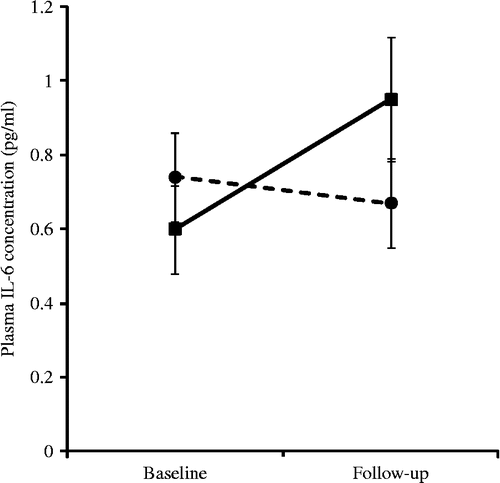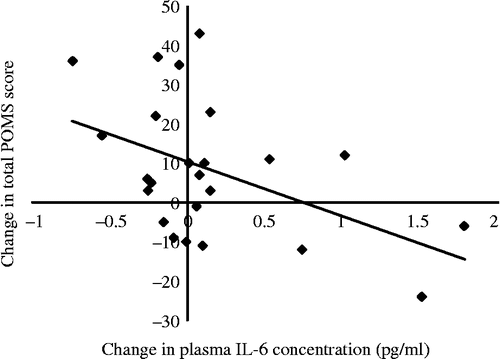Figures & data
Table I. Intensity band boundaries for accelerometer calibration (min/day).
Table II. Characteristics of the sample at baseline.
Figure 1. (a) Mean GHQ score at baseline and 2-week follow-up assessments in exercise withdrawal (dashed line; n = 13) and exercise maintenance (solid line; n = 13) conditions. Vertical lines represent SE of the means. Significant group difference at follow-up, and with time in the withdrawal group (independent t-tests, p < 0.05). (b) Mean POMS score at baseline and 2-week follow-up assessments in exercise withdrawal (dashed line; n = 13) and exercise maintenance (solid line; n = 13) conditions. Vertical lines represent SE of the means. Significant group difference at follow-up, and with time in the withdrawal group (independent t-tests, p < 0.01).

Figure 2. Mean plasma IL-6 concentration (non-transformed data) at baseline and 2-week follow-up assessment in exercise withdrawal (dashed line; n = 13) and exercise maintenance (solid line; n = 13) conditions. Vertical lines represent SE of the means.

Table III. Summary of hierarchical regression analysis for variables predicting total POMS change.
Figure 3. Correlation between change in mood disturbance and 2-week change in plasma IL-6 concentration (r = − 0.49, n = 24, p = 0.016). Note that an increase in POMS score reflects an increase in mood disturbance at follow-up.

Figure 4. Mean POMS score at baseline and 2-week follow-up assessments in exercise withdrawal/low fitness (dashed line, circle; n = 5), exercise withdrawal/high fitness (dashed line, diamond; n = 6), exercise maintenance/low fitness (solid line, square; n = 7) and exercise maintenance/high fitness (solid line, triangle; n = 6). Vertical lines represent SE of the means. The exercise withdrawal/high-fitness group POMS score was greater at follow-up than the exercise maintenance high and low-fitness groups (independent t-tests, p < 0.005).
